
Chất độc trong quần áo nhiều hơn chúng ta tưởng
Bởi: Madeleine Almberg

Các người mẫu trên sàn catwalk tại buổi trình diễn thời trang Lela Rose trong tuần lễ thời trang Mercedes-Benz 2014, tại trung tâm Lincoln ngày 9 tháng 2 năm 2014 (Andrew H. Walker/Getty Images)
STOCKHOLM, Thụy Điển – Căn cứ theo một nghiên cứu bởi Cơ quan Hóa Chất Thụy Điển, quần áo có chứa nhiều chất độc hơn chúng ta từng biết.
Khi sản xuất quần áo, một lượng lớn hóa chất được dùng, vào khoảng 3 kg hóa chất trên mỗi kg vải. Rất nhiều hóa chất gây dị ứng như chất bảo quản và các chất chống ẩm mốc.
Một vài hóa chất có thể gây ung thư, rối loạn hormone, hay thậm chí là gen di truyền, như chất arylamines dùng để nhuộm màu. Những chất này cũng có hại đối với môi trường.
Marianne Jarl là thanh tra viên của Hiệp Hội Hen suyễn và Dị ứng Thụy Điển – đây là một tổ chức phi chính phủ ở quốc gia này. Bà cho biết “Rất nhiều hóa chất đang được sử dụng chưa được kiểm định từ phương diện ảnh hưởng tới sức khỏe, và nhiều hóa chất khác cũng đang liên tục được đưa vào sản xuất nhưng chúng ta biết rất ít về nó”.
Cơ quan Hóa chất Thụy Điển đã xác định được 2400 loại hóa chất trong bản báo cáo. Khoảng 10% trong số này có thể gây nguy hại cho sức khỏe và môi trường. Trong đó cũng nhắc đến thuốc nhuộm trong quần áo gây dị ứng, Luật EU cấm sử dụng chất này.
Bà Jarl cho biết “Vải chủ yếu được sản xuất bên ngoài Châu Âu, điều này có nghĩa là luật lệ chung của EU về hóa chất (gọi là REACH) không được áp dụng. Ở Châu Á, luật về hóa chất cực kì lỏng lẻo, và các quốc gia nhập khẩu quần áo không thể biết được có bao nhiêu loại hóa chất đang được sử dụng”.
Ảnh hưởng tới môi trường
Những hóa chất gây hại này không chỉ ảnh hưởng người mặc, mà còn tới cả môi trường và công nhân sản xuất. Chịu ảnh hưởng nặng nhất là những quốc gia sản xuất, vì các nhà máy dệt may thường xả thẳng nước thải bị ô nhiễm ra môi trường.
Tương tự, một lượng lớn thuốc trừ sâu cũng được dùng trong canh tác cây bông. Một số hóa chất có thể lan sang các quốc gia khác, và làm ô nhiễm môi trường quốc gia đó. Nonyphenol là một trong số đó, chất này được phát hiện bởi các nhà máy xử lý nước cống ở Thụy Điển.
Thậm chí sợi vải hữu cơ cũng không chắc là không chứa các hóa chất độc hại. Các hóa chất có thể được thêm vào trong quá trình sản xuất như nhuộm, in, tẩy trắng.
Nhiều hóa chất độc hại vẫn được cho phép
Theo Martha Sedvallson, Giám đốc Hiệp Hội hen Suyễn và Dị ứng Thụy Điển, có quá nhiều hóa chất độc hại đang cho phép lưu hành. Thêm nữa, chúng ta biết quá ít về ảnh hưởng của những loại chất này lên cơ thể người và môi trường như thế nào, ngay cả với giới hạn cho phép hiện tại.
Bà nói “Cho dù nếu nhiều công ty sẵn sàng tuân thủ luật, chúng ta cũng không biết được tác động của các hóa chất nếu chúng được trộn lẫn với nhau trong quá trình sản xuất”.
Một số hóa chất được rửa đi nếu bạn giặt đồ lần đầu tiên, nhưng chất thải sẽ ra môi trường tiếp tục gây hại.
Bà Marianne Jarl cho biết: “Vấn đề lớn nhất về việc sử dụng hóa chất là cách làm truyền thống đã có từ hàng trăm năm nay, cho rằng hóa chất cần phải bị đánh giá là cực kỳ nguy hiểm thì mới bị cấm”.
Bà lập luận rằng việc kiểm tra hóa chất ngày càng tụt hậu, đồng thời có quá ít sự quan tâm về vấn đề hóa chất ảnh hưởng sức khỏe và môi trường như thế nào, cho dù một số nhà sản xuất lớn cũng có vẻ quan tâm.
Bà Jarl nói: “Chúng tôi cảm thấy gánh nặng này cần được thay đổi: một loại hóa chất nên được thẩm định hệ quả tới sức khỏe và môi trường trước khi đưa vào sản xuất hàng loạt trong công nghiệp hay quy mô gia đình. Nhưng thật không may là con đường tới đó dường như dài vô tận”.
More Toxins in Clothes Than Previously Believed
By Madeleine Almberg, Epoch Times | November 23, 2014
Last Updated: December 4, 2014 7:21 pm

Models walk the runway at the Lela Rose fashion show during Mercedes-Benz Fashion Week Fall 2014 at Lincoln Center for the Performing Arts in New York City on Feb. 9, 2014. (Andrew H. Walker/Getty Images)
Models walk the runway at the Lela Rose fashion show during Mercedes-Benz Fashion Week Fall 2014 at Lincoln Center for the Performing Arts in New York City on Feb. 9, 2014. (Andrew H. Walker/Getty Images)
STOCKHOLM, Sweden—Clothes contain much more toxic chemicals than previously known, according to a study by the Swedish Chemicals Agency.
When manufacturing clothes, large amounts of chemicals are being used, about three kilogram for one kilogram of clothes. Many of these substances, like preservatives and substances to prevent mold, cause allergies.
Some of these chemicals can cause cancer, or disrupt the hormone system, or even the human DNA, such as arylamines formed by azo colors. They are also harmful to the environment.
“Many used chemicals have not been evaluated from a health standpoint, and new chemicals are constantly being brought in, which we know very little about,” said Marianne Jarl, ombudsman of the Swedish Asthma and Allergy Association, a Swedish NGO.
In a report published October 3, 2014, the Swedish Chemicals Agency identified 2,400 substances. About ten percent of these could pose a danger to both humans and their environment. There are also allergic dyes in clothes that are not permitted by European Union (EU) regulation.
“Textiles are mostly manufactured outside of Europe,” said Jarl. “This means that the common EU regulation for chemicals, called REACH, is not being applied. In Asia, chemical legislation flaws incredibly, and importing countries may not know at all what kind of chemicals are being used.”
Environmental Impact
These harmful chemicals are not only affecting the people wearing the clothes, but also our environment, and the people who manufacture the clothes. Worst affected are the countries where the production takes place, as textile factories sometimes release contaminated waste water directly into the environment.
Also, large amounts of harmful pesticides are used when growing cotton. Some of these substances can spread to other countries, and harm the environment there as well. One such substance is nonylphenol, which has been detected in Swedish sewage treatment plants.
Not even supposedly organic cotton is guaranteed to not contain harmful chemicals. They may be added during various processes, such as bleaching, dyeing, or printing.
Many Harmful Chemicals Still Allowed
According to Martha Sedvallson, President of the Swedish Asthma and Allergy Association, there are just too many dangerous chemicals that are still allowed. In addition, we know far too little about how harmful chemicals affect humans and the environment, even with current regulated limits.
“Even if companies choose to stay within the limits, there is no knowledge about the effects if several different harmful chemicals are being mixed in the process,” she said.
Some of these chemicals are washed away if you wash your clothes for the first time, but they end up in the environment, where they continue to do damage.
“The biggest problem with the use of chemicals, is the practice that has been developed over the last hundred years or so, that says a chemical needs to be classified as very dangerous before it is banned,” Marianne Jarl said.
She argues that the testing of chemicals is constantly lagging behind, and that there is little interest in looking at how chemicals affect our health and environment. Not even the major manufacturers seem very interested, she thinks.
“We feel that the burden of proof should be reversed: a chemical should be evaluated for its impact on health and environment, before large-scale production and industrial or household use is allowed,” Jarl said. “Unfortunately, the road to get there seems endless.”
Read the original Swedish article here.
More in Health News
Toxic Threads - Product Testing Results
Our latest Detox campaign report found residues of a variety of hazardous chemicals in clothing made by 20 global fashion brands. This page contains examples of the results we found including widespread use of nonylphenol ethoxylates (NPEs), which break down in the environment to form hormone-disrupting chemicals.
It is important to note that the levels of chemicals detected are not known to constitute any direct health risk to the wearers of these garments. However, these chemicals have a range of hazardous effects on human health and other organisms when released into the environment. The only way to deal with them is for brands to stop using them completely and find safer alternatives.
Browse the images below and share them in social media to pressure these brands to clean up their act and Detox. For more details please Download the Full Report or visit our Priority Chemicals for Elimination page.
All products
Nonylphenol Ethoxylates
Phthalates
Amines
Men
Women
Kids
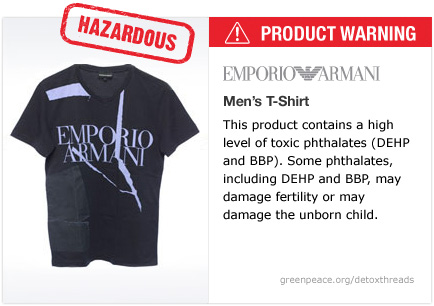
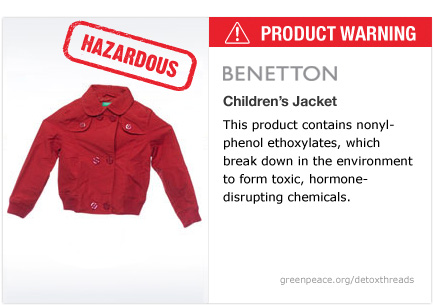

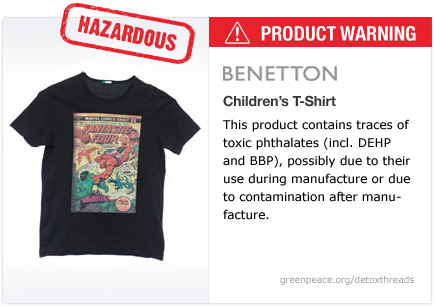

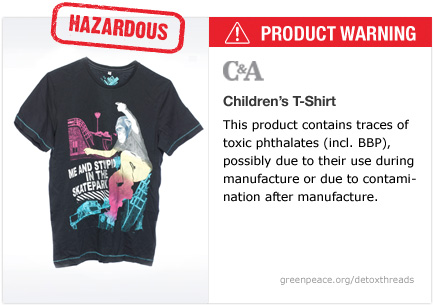
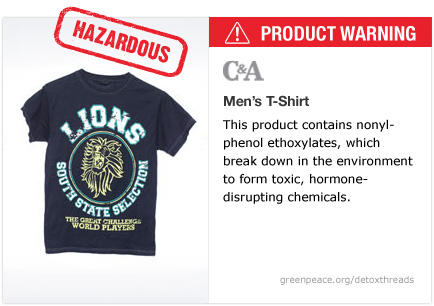
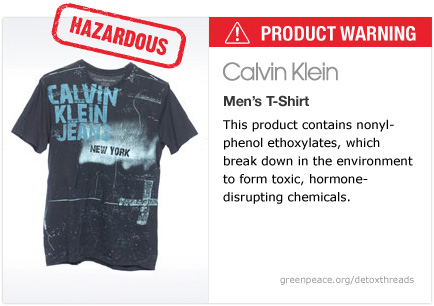
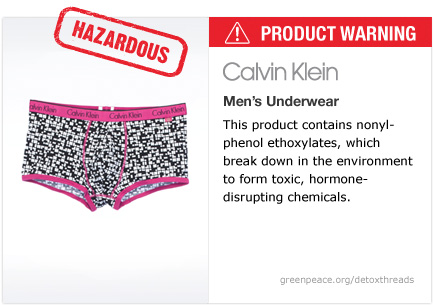
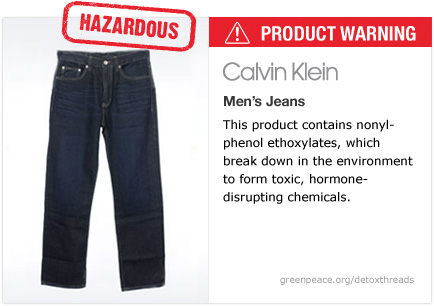

.jpg)
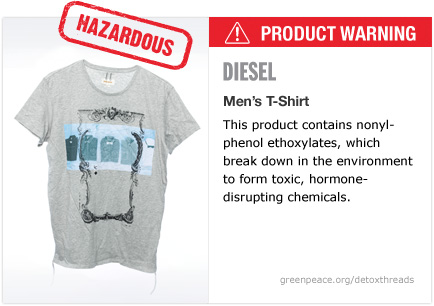

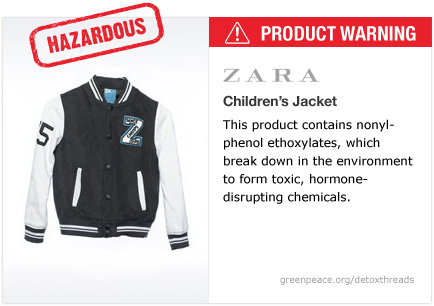
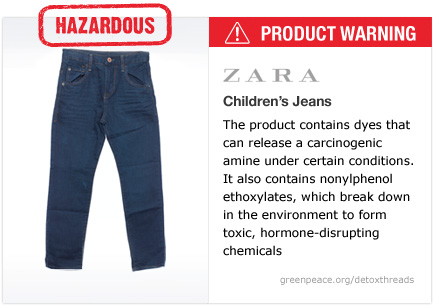

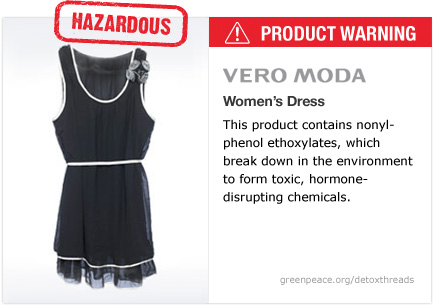
.jpg)



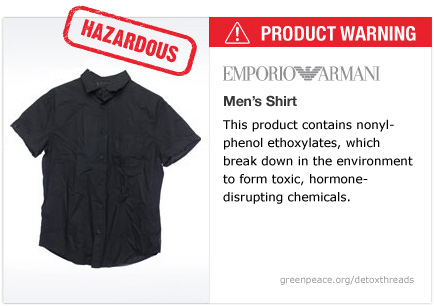







.jpg)